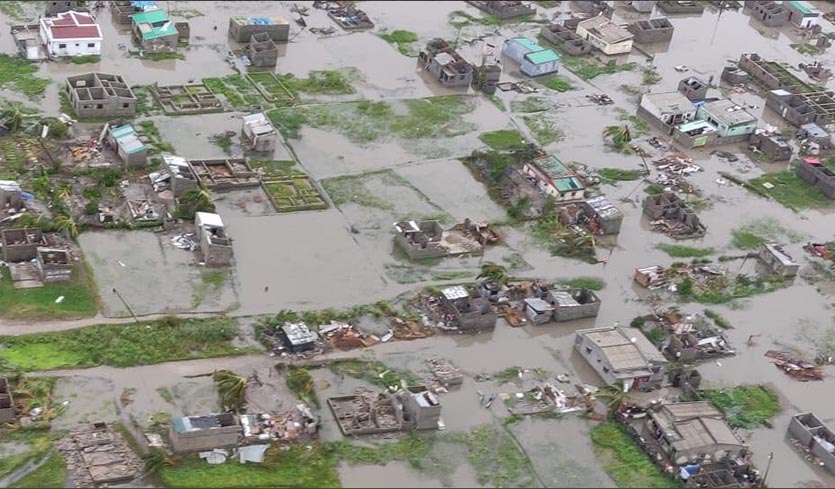| Above: Rooftops and tops of palm trees poke out from underneath flood waters from Tropical Cylone Idai's storm surge and river floods in Beira, Mozambique. Image credit: MozSARescue. |
An extreme humanitarian crisis is unfolding in Mozambique, where catastrophic Tropical Cyclone Idai made landfall on Thursday evening as a Category 2 storm with 110 mph winds. Mozambique president Filipe Nyusi told Mozambican radio on Monday that he had seen “many bodies” floating in the overflowing Pungwe and Busi rivers, and “it appears that we can register more than 1,000 deaths.”
 |
| Figure 1. Severe wind damage and flooding in Beira, Mozambique, in the wake of Tropical Cylone Idai. Image credit: International Federation of Red Cross. |
Aerial survey images show that the coast of central Mozambique where Idai made landfall suffered severe damage from all three of the major hazards of a tropical cyclone: wind, storm surge, and flooding rains. As Idai approached the coast, the stronger left eyewall of the storm moved over Beira (population 530,000) near the time of high tide, driving a large storm surge into the city. Beira is Mozambique’s fourth largest city, and second largest port. The city is very low-lying, with portions lying below sea level. The city has no power, no communications, and flooded access roads, though the airport has some limited accessibility.
The scale of #CycloneIdai in Beira, Mozambique, is truly heartbreaking. Initial assessments from @ifrc estimate at least 90% of the area is completely destroyed. Read what IFRC aid workers are witnessing in the area: https://t.co/reDWmHKw2W @IFRCAfrica pic.twitter.com/25l3kM2vl3
— American Red Cross (@RedCross) March 18, 2019
A list compiled Monday by AFP from official sources puts the death toll from Idai’s landfall in Mozambique at 68, including 55 in Beira alone. These deaths are in addition to the 66 deaths recorded in northern Mozambique the week before Idai’s landfall, due to flooding from the tropical disturbance that developed into Idai. Flooding from that disturbance also killed 56 people in Malawi. Cuamba, Mozambique received 11.14” of rain in just 12 hours on March 7 from the tropical disturbance that become Idai.
Bridges damaged as floods sweep across part of Manicaland #CycloneIdai pic.twitter.com/GZWyyb6QuX
— Bhekimpilo Ntini (@Bheki_Ntini) March 16, 2019
Zimbabwe: at least 98 dead
Idai brought up to a foot of rain to eastern portions of Zimbabwe near its border with Mozambique. The resulting floods have killed at least 98 people, with 217 missing and 102 injured, said government officials on Monday. Zimbabwe’s death toll from Idai is expected to rise, since the hardest-hit district of Chimanimani remains inaccessible due to damaged roads and main access bridges that have been washed away.
According to EM-DAT, this is the second deadliest flood on record for Zimbabwe. The deadliest was in January 2017, when 251 people died from flooding due to Tropical Cyclone Dineo.
 |
| Figure 2. Seven-day satellite-estimated rainfall amounts for Idai. Rainfall in excess of two feet (pink colors) fell in central Mozambique, with up to a foot (dark red colors) in eastern Zimbabwe. This map does not show the heavy rains in excess of a foot that Idai’s precursor tropical disturbance dumped over northern Mozambique and southern Malawi before March 11. Image credit: NASA. |
One of the deadliest Southern Hemisphere tropical cyclones on record
Idai is among the Southern Hemisphere's deadliest tropical cyclones on record. Using data from EM-DAT, the international disaster database, plus other official and unofficial sources, the 288 deaths officially attributed to Idai so far would make it the eighth deadliest Southern Hemisphere tropical cyclone on record. As is usual for catastrophic storms, there is considerable uncertainty in these numbers:
Deadliest Southern Hemisphere Tropical Cyclones
-------------------------------------------------------------------------------------------------------------
Deaths Storm Location Year
- 1200 Unnamed Mauritius 1892
- ~800 Eline Mozambique, Madagascar, Zimbabwe 2000
- 517 Unnamed French Polynesia 1903
- ~500 Unnamed Madagascar 1927
- 418 Gafilo Madagascar 2004
- 300+ Mahina Australia 1899
- 300 Emilie Mozambique 1977
- 276 Indlala Madagascar 2007
- 252 Nadia Mozambique, Madagascar 1994
- 251 Dineo Zimbabwe 2017
Notes: The deadliest Mozambique tropical cyclone on record is Eline of 2000, which hit southern Mozambique as a Category 4 storm with 130 mph winds on February 22, 2000. Eline dumped torrential rains on a region that was already suffering severe flooding from over a month of heavy rains, and the combined floods killed over 700 people in Mozambique, according to Meteo-France (thanks go to Philippe Caroff for this link). Eline also killed 12 people in Zimbabwe and 64 in Madagascar, bringing the storm’s total death toll to nearly 800. There is some uncertainty on how many of the deaths in Mozambique can be attributed to the flooding that came before Eline, though.
The January 13, 1903 cyclone that killed 517 people in Tahiti and surrounding islands is well-documented in a detailed history of tropical cyclones in the Pacific, the 2012 book Furious Winds and Parched Islands: Tropical Cyclones (1558–1970) and Drought (1722 – 1987) in the Pacific, by AnaMaria d’Aubert and Patrick D. Nunn. There are also two newspaper accounts (here and here) of the January 13, 1903 cyclone, saying that it brought a 40-foot high wave that inundated Tahiti and neighboring islands, killing as many as 5,000 – 10,000 people. However, another newspaper article mentions that a significant earthquake occurred that day as well, and the extreme wave observed during the cyclone may have been a tsunami from an earthquake. Thanks go to Jeffrey Callaghan for these links.




